12 Types of Keywords in SEO You Need to Know
The goal behind keyword research is to discover search terms that get the right audience to your website. Once people find your business online, you can convert them into leads and then into customers.
But to get this process going, you need to familiarize yourself with SEO keywords.
In this article, we’ll introduce you to the categorization most SEO experts apply to keywords. By understanding how keywords are distributed among different groups, allocating your SEO resources more efficiently and targeting the right search terms will come more naturally.
Get a free copy of our research findings and sign up to SE Ranking’s news and SEO tips digests!
Click the link we sent you in the email to confirm your email
Keyword Types Based on Length
Let’s start by categorizing keywords using a length-based approach. Under this classification, keywords fall into three types: short-tail, medium-tail, and long-tail.
Short-Tail Keywords
Short-tail keywords (also known as head search terms) are brief phrases with no more than two words. People use short-tail keywords to conduct broad searches or seek general information. These are typically going to be the first words that come to your mind when describing your business. The same goes for customers; these are the keywords they use at the initial stage of their customer journey.
These keywords often have a high search volume and can generate tons of traffic.
Here are some examples of short-tail keywords:
- cookies
- AI-powered tool
- winter sweater
- library
- Google algorithms
But despite their ability to generate tons of traffic, short-tail keywords lack specificity, making them difficult to rank for. Let’s say someone performs a search using the “spicy food” query. Google might not be able to discern the intention the user has behind this keyword. This is why SERPs for this search term can include recipe blogs, restaurants, and health information websites—all on the same SERP.
Noticing a pattern here? Short-tail keywords are highly competitive, so it’s generally not advised to try ranking for them right away. This is especially true if your business is just starting out or you haven’t already established yourself as a leading authority in your industry.
To appear on less competitive SERPs and attract an audience with a more defined intent, it’s recommended to focus on long-tail keywords instead.
Long-Tail Keywords
The descriptor “long tail” speaks for itself.
Long-tail keywords are highly-specific search terms that comprise over three or four words. They usually have a low search volume but low competition. This makes it easier to rank for them.
Here are some examples of long-tail keywords:
- peanut butter cookies recipe without eggs
- AI-powered content creation tool for SEO
- winter sweaters to add to your closet for women over 50
- best libraries for kids in St. Louis
- history of Google’s algorithm updates
Since these keywords are more specific, they are generally more effective at driving qualified traffic. Let’s say your food blog appears at the top of SERP for the “peanut butter cookies recipe without eggs” query. You’re way more likely to attract the right audience using this query than if you tried ranking for a short-tail query like “peanut butter cookies.” This is because people who use long-tail keywords have a clearer idea of what they expect to find from their search.
And compared to short-tail keywords, long-tail keywords have higher conversion rates.
Medium-Tail Keywords
Finally, let’s explore medium-tail keywords. This is another keyword type categorized by length that combines the advantages of both short-tail and long-tail search terms.
Medium-tail queries typically consist of three words and have decent specificity. This makes them less competitive than their short-tail counterparts. But these keywords still boast a good level of search volume, unlike some long-tail keywords with little to no monthly searches.
Here are some examples of medium-tail keywords:
- chocolate cookies recipe
- oversized winter sweaters
- local public library
- Google algorithm update
When optimizing for medium-tail keywords, expect to generate a decent volume of traffic and experience less competition in search results.
To illustrate this point further, pretend you’re focusing on a broad keyword like “gardener.” Due to the high competition of this short-tail keyword, you’re unlikely to rank well for it. On the other hand, by focusing on a very specific keyword like “hire a gardener for a day to cut grass,” you run the risk of hearing crickets because almost zero people are actually typing in this query. Instead, using a medium-tail keyword like “experienced landscape gardener” can help you maximize your chances of ranking high and attracting the right audience.
How to Find Short-Tail, Medium-Tail, and Long-Tail Keywords
With the help of professional SEO tools like SE Ranking, homing in on different keyword categories is easy.
Our Keyword Research Tool is a great starting point for finding short-tail, medium-tail, and long-tail keywords. Start by entering your chosen keyword into the corresponding field. The system will then analyze it using core SEO metrics before presenting you with several lists of keyword ideas.
In the tool’s Keyword Suggestions tab, you can find a list of similar, related, question-based, and low search volume keywords, which are generated based on the head keyword you entered into the tool.
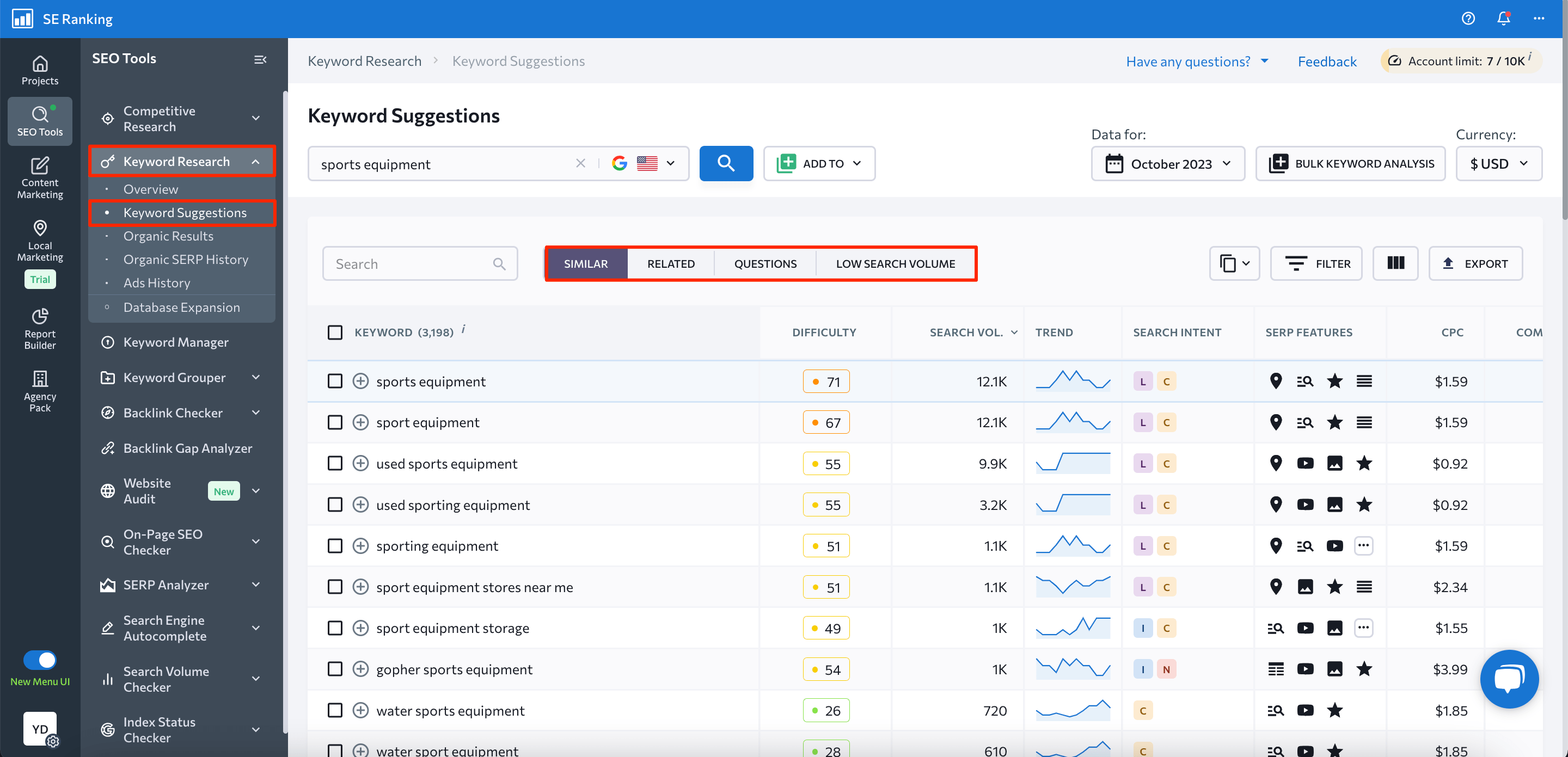
From here, you can apply filters to your keywords. By filtering them based on word count, you can sort them out using a length-based approach.
It’s also possible to open any keyword-related report within the SE Ranking system and apply filters that specify the necessary word count for keywords in the list (two words or less for short-tail keywords, and four plus words for long-tail keywords).
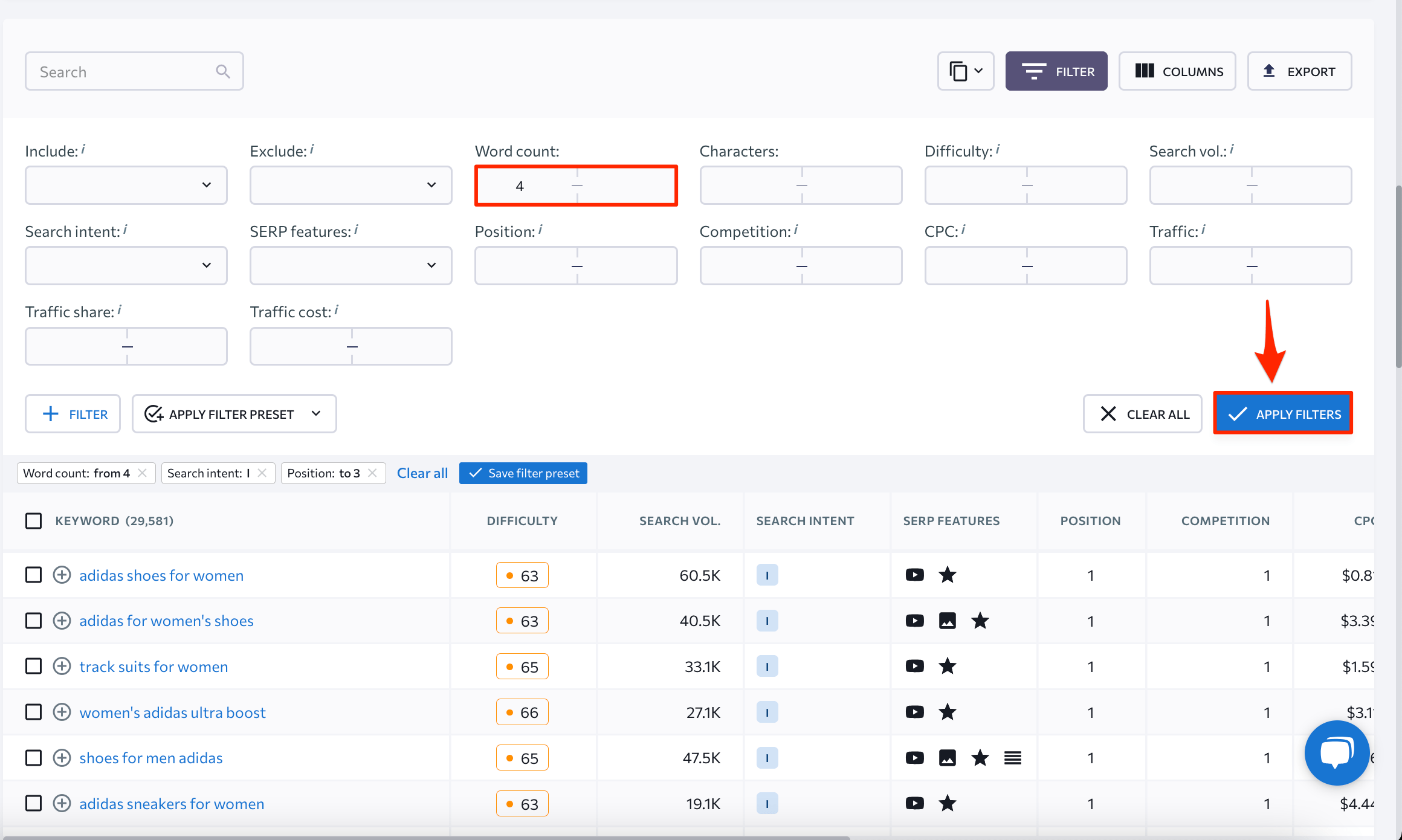
And there you have it. By now, you should have your list of either short-tail, medium-tail, or long-tail keywords, each of which has been analyzed using SEO metrics that can be selected according to your needs. Either download this keyword list in .CSV or .XLS format or add it to Keyword Manager for further processing. In Keyword Manager, you can add keywords to a specific SE Ranking project or to the list of search terms made for your articles in the Content Editor.
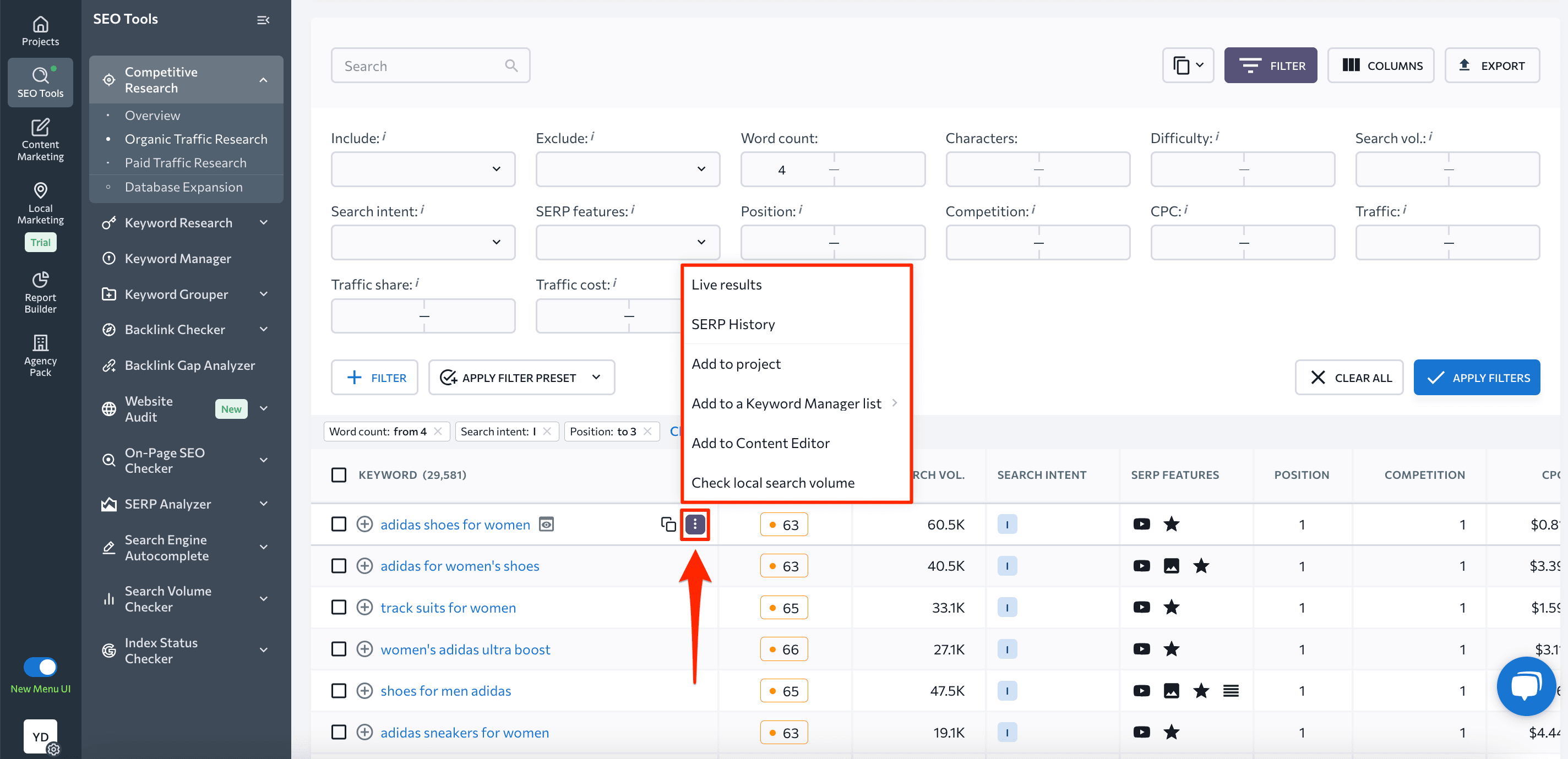
Intent Targeting Keywords
Next, keywords can also be grouped depending on user intent. There are five main keyword categories based on user intent:
- Informational
- Navigational
- Commercial
- Transactional
- Local
Let’s review these types of SEO keywords in more detail.
Informational Keywords
People use informational keywords to gather knowledge, find answers to their questions, or educate themselves about a topic.
Even though informational keywords have low conversion rates and are generally challenging to rank for, producing informative content around them helps you establish authority in your niche and build trust with your audience. Also, introducing your product/service in a way that conveys the full value of your business naturally nudges customers into the next phase of their buying cycle.
You can identify informational keywords by modifiers like “how to,” “what is,” “tips for,” or “guide to.” For example:
- How to build a successful business
- What is psychoanalysis
- Tips for improving memory
- Practical guide to start freelancing
Navigational Keywords
As a rule, anyone who tries to reach a specific website, online store, or social media profile is using navigational keywords. Search terms like these typically contain an organization’s name, a website, or a product.
Here are some examples of navigational keywords:
- Facebook log in
- Amazon Prime
- OpenAI blog
- Pinterest sign up
You don’t have to work too hard to optimize for navigational keywords. Just make sure you have all pages people are looking for when they search for or about your brand. From there, it’s only a matter of time before Google puts you at the top of SERP for those specific queries.
For instance, if people search for “[your company name] pricing,” create a separate page with all the pricing plans or details that you offer. You should also make sure to mention your brand or product name on the following pages: your homepage, landing pages, About Us page, Contact Us page, blog posts, and key product/service descriptions.
Commercial Keywords
Commercial keywords are most often used by people with a clear interest in making a purchase decision. However, some of these potential customers may not have reached a decision about what option works best for them yet. It isn’t uncommon for people who use these queries to continue researching the product to fully understand its pros and cons.
You can identify these keywords by taking a look at their modifiers. Some of the most commonly used ones are:
- Best
- Comparison
- Review
- Top-rated
- Vs
- Alternative
And typical commercial keywords look something like these:
- best web hosting for small business
- Spotify vs Apple Music
- top-rated car seats for infants
- review of vacuum cleaners
- comparison of instant cameras
Since commercial keywords indicate that people are further down the buying journey, optimization for these search terms provides businesses a great opportunity to capture valuable leads.
Transactional Keywords
This type of keyword is used by people who are ready to make a purchase or take a specific transactional action (e.g., signing up for a newsletter, downloading an eBook, or any other marketing campaign-related action).
Transactional phrases often include words like “buy,” “order,” “purchase,” “discount,” or “coupon.” Here are some examples of keywords that include these modifiers:
- buy vinyl records
- order lab tests online
- purchase Kindle books
- outdoor toys discount
- movie tickets coupons
The main benefit of strategically distributing transactional keywords throughout your website content (especially landing pages and product descriptions) is that you can significantly increase conversion rates. In fact, people performing searches using transactional queries have typically done all the necessary research about the product/service, making them way more likely to convert.
Local Keywords
Local keywords are specifically associated with the actual geographic area where a user is looking for a product, service, or information. These search terms typically contain locale-specific indicators like region/country/state/city names, neighborhoods, zip codes, or even region-specific landmarks.
Take a look at some examples of local keywords:
- pet-friendly restaurants in London
- Barcelona live music events
- dentist near Phinney Ridge
- Chicago guided tours
Producing high-quality content around local keywords can boost your local search rankings and get more people coming to your store. Plus, local keywords are key for mobile searches, which have been on the rise lately. With more people using their phones to look for the places, events and things near them, having a good local SEO strategy is even more important.
How to Find Informational, Navigational, Commercial, Transactional, and Local Keywords
Begin by identifying the intent behind a keyword. You can do this in just a few clicks using SE Ranking’s Keyword Research Tool. Simply enter the desired keyword and the system will quickly analyze it using a set of essential SEO metrics (including search intent). From there, you can see the keyword intent at the top of the Overview section.
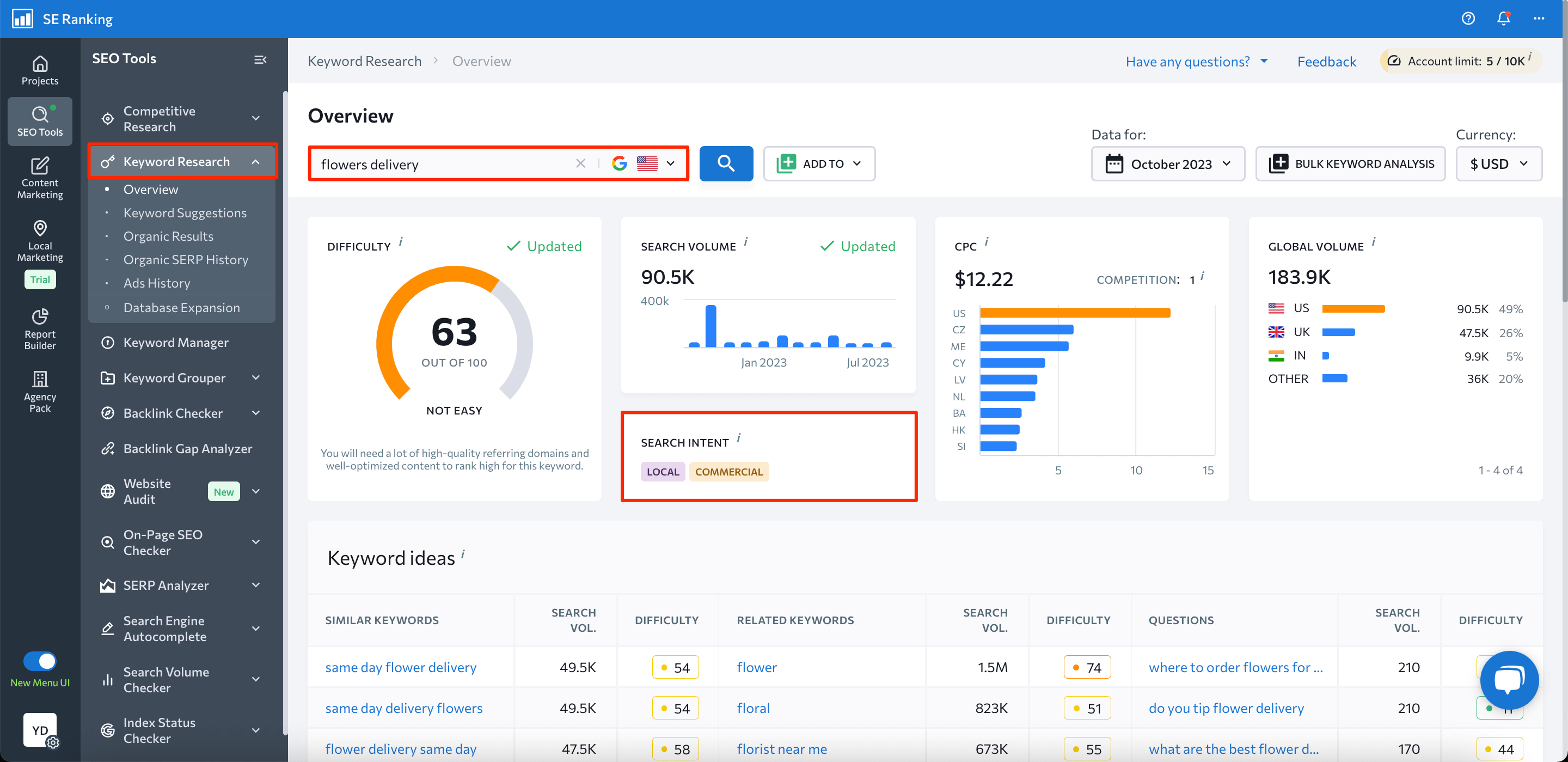
It’s also possible to identify keywords based on their search intent by taking a look at the corresponding column in the keyword-related report. For example, if you want to discover the intent behind search terms that your competitors rank for, do the following: go to the Competitor Research Tool, enter your competitor’s domain name or URL, and then take a look at the Organic Traffic Research section.
Here, you’ll find a list of all the keywords your rival ranks for. The platform presents a wide range of metrics, including Search Intent. By using the tool’s filtering options, you can filter out queries based on a specific intent.
Let’s say you want to find all informational keywords that your competitor appears at the top of the SERP for. To do this, select this specific search intent in the Filters block, limit the ranking position to no more than three, and click Apply Filters.
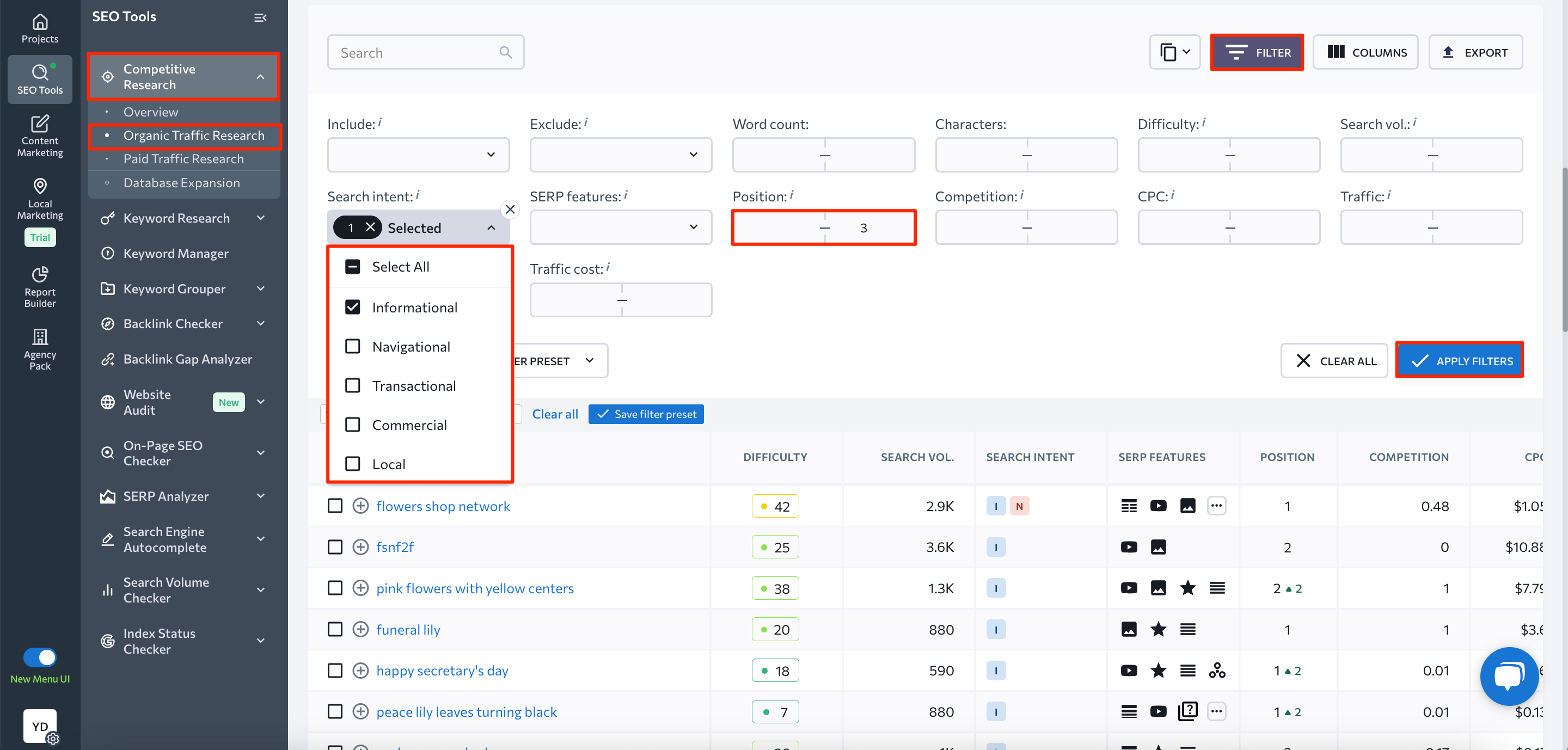
This will help you find a list of specific keyword types that are helping your competitors occupy top SERP positions.
Learn more about an SEO strategy that compares your website’s keywords with those of your competitors to uncover content gaps in this guide.
Other SEO Types of Keywords to Consider
Some keyword types don’t fall into any of the categories outlined above, but they still play an important role in modern SEO.
LSI Keywords
Before we discuss LSI (Latent Semantic Indexing) keywords and how to use them to build a successful SEO strategy, let’s start with the basics.
So, what is LSI?
LSI keywords are search terms related to the primary keyword you’re optimizing for. These keywords are designed to provide additional context, thereby assisting users and search engine crawlers in understanding the purpose of your content.
Let’s say you target a keyword like “jaguar.” Depending on the context, it can have two different meanings. Google uses LSI technology to provide the most relevant results on the SERP and meet users’ expectations.
- If the search engine detects keywords like “wildcat,” “roar,” “safari,” “endangered species,” “jungle,” and “feline,” throughout your content, it will understand that you’re writing about the “jaguar” animal species.
- On the other hand, if Google detects words like “luxury car,” “sports car,” and “automobile” on your webpage, it will detect that your topic revolves around the high-end car manufacturer known as “Jaguar”.
Even though Google representatives have stated that LSI keywords don’t technically exist, this doesn’t mean that you should forget about using related keywords in your content altogether. One thing is certain, Google considers the relevance of content to be a significant ranking factor. To make sure that the information on your page relates to a specific search query, incorporating LSI keywords into your content is key.
How to Find LSI Keywords
One of the easiest ways to find your LSI keywords is by using tools like SE Ranking’s Content Editor. When creating a brief for your content piece, you’ll see a list of suggested keywords to include in the article. You’ll find LSI options among them.
For example, if your head search term is “content audit”, you will find the following LSI keywords (these keywords are underlined in red in the screenshot below):
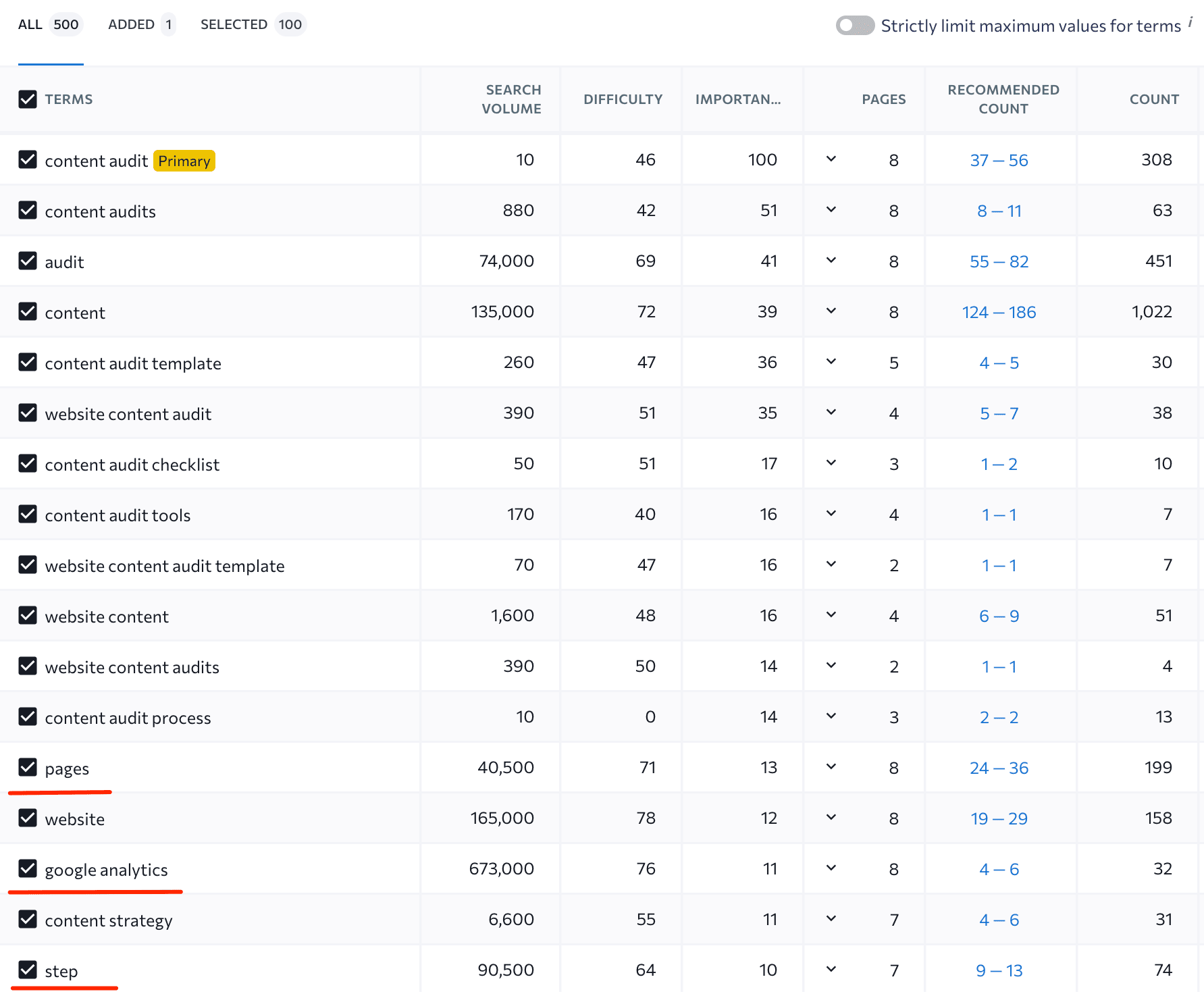
Question-Based Keywords
These keywords tend to be long-tail keywords with informational search intent. They typically start with probing words like who, what, when, where, why, or how.
Question-based keywords should not be ignored. Just because they indicate that a person is at the initial stage of the buyer’s journey, it doesn’t mean that they don’t provide commercial value. You can leverage question-based keywords by presenting your product/service as the solution to the problem indicated in the query.
What’s more, the best thing about these keywords is that they often have a high search volume and relatively low competition. This makes them a goldmine for improving SEO performance and increasing website traffic.
Create blog posts, articles, a separate content section, and videos about topics that your target audience is interested in. Highlight how your products/services can help them address their problems. At the very least, your content will have a chance to appear at the top of the SERP above organic results and attract the right audience to your website.
By providing insightful answers that incorporate the use of your brand, you’ll be able to guide people directly to the transitional stage of their funnel cycle and convert them into paying customers.
How to Find Question-Based Keywords
SE Ranking’s Keyword Research Tool also presents a pre-made report with question-based queries.
After entering your seed keyword into the tool, go to the Keyword Suggestions tab. This is where you can find four lists with suggested keyword ideas. One of these lists is made specifically for question-based terms that include the query you entered at the start.
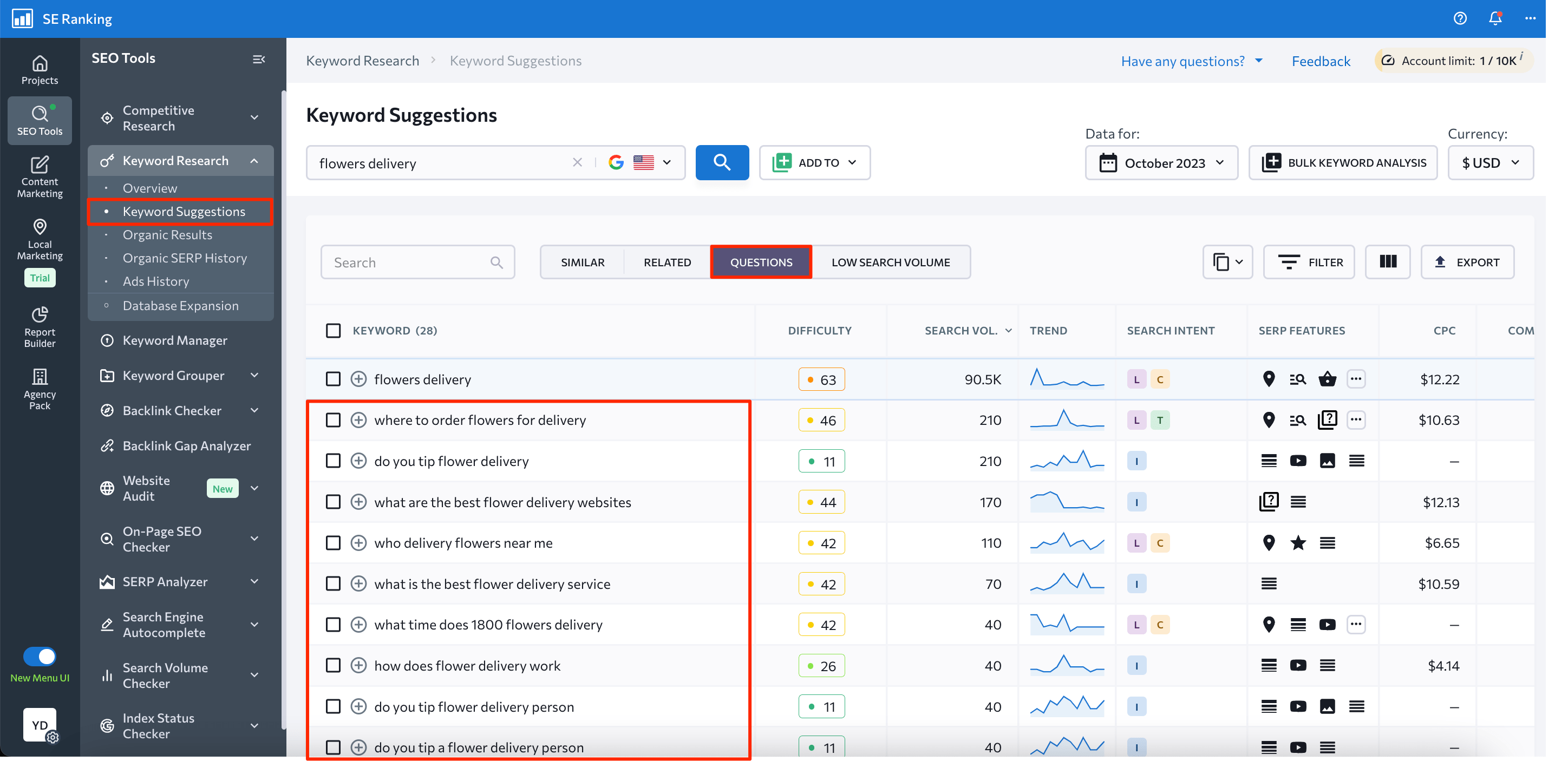
Here, you can also apply filters to your keywords by word count, difficulty, search volume, user intent, SERP features, CPC, competition, and the include/exclude feature.
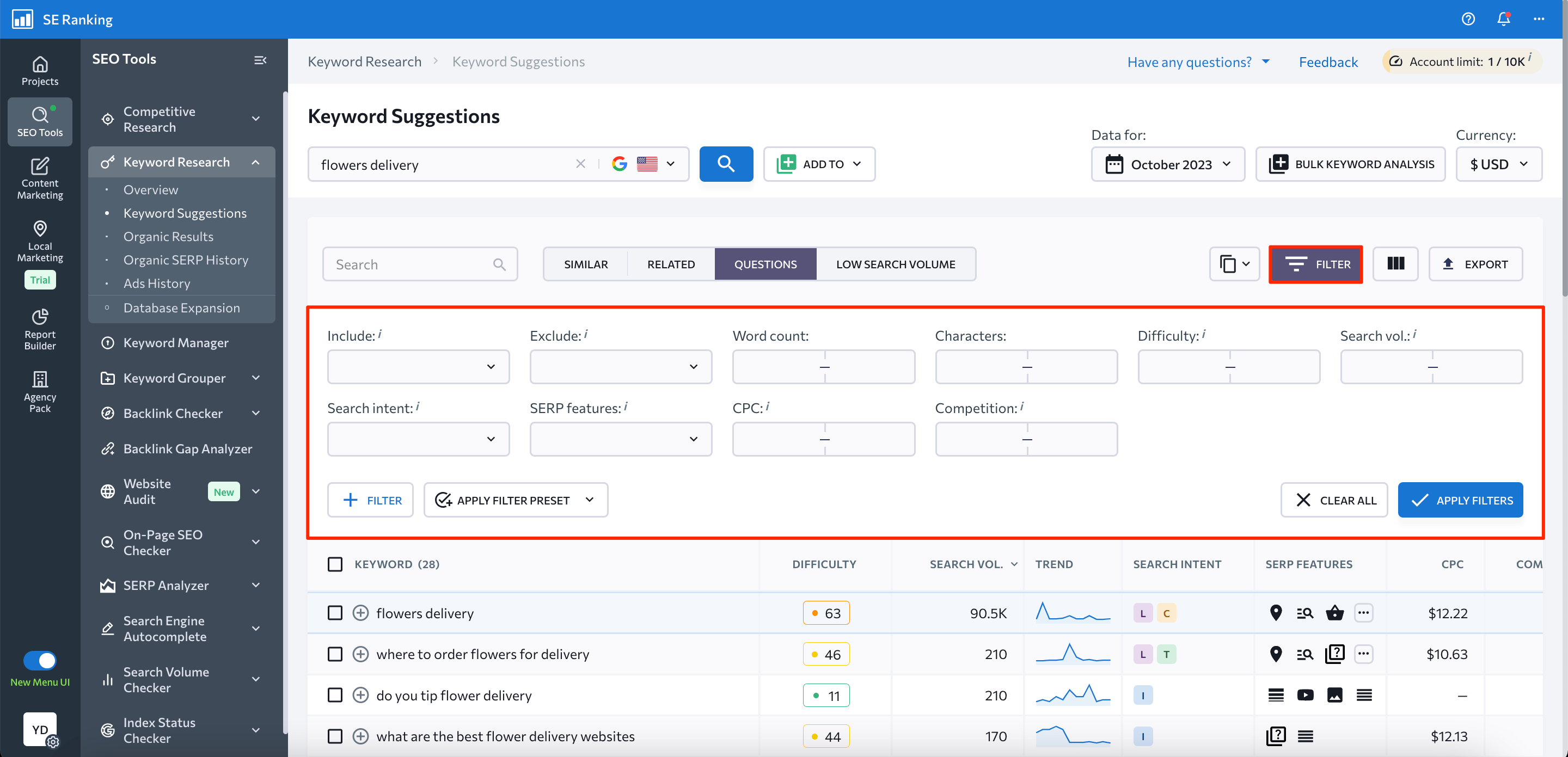
Trendy Keywords
These keywords experience a rapid surge in popularity and search volume due to current events, holidays, or specific seasons. Trendy keywords are usually very short-lived and are pretty easy to rank for. But to reach the top of the SERP for these queries, you must produce high-quality content around them, and before big-name sites do the same.
Let’s put this into perspective by using SE Ranking (our company) as an example. At one point, Google announced that it was upgrading its AI-powered results. We responded by publishing a blog post with trendy insights around this topic. In only a few weeks after publishing this article, we received a large amount of organic traffic.
Optimizing content for trendy keywords also encourages sharing and discussion on different social media platforms. This showcases the relevance of your content to current events or popular topics. This helps you increase your reach and engagement.
How to Find Trendy Keywords
You can easily identify trending keywords through tools like Google Trends, Twitter Trends, or BuzzSumo.
For instance, Google Trends shows the popularity and relevance of different search terms across regions, so you can always make data-driven decisions on which topics to cover. In particular, within the Trending Now section, you can find both daily and realtime search trends categorized in different groups (e.g., business, health, entertainment, sports. sci/tech) in a specific geographical area.

You can go through the list to identify emerging keyword trends along with a chart showing elevated or decreased news interest in the trend.
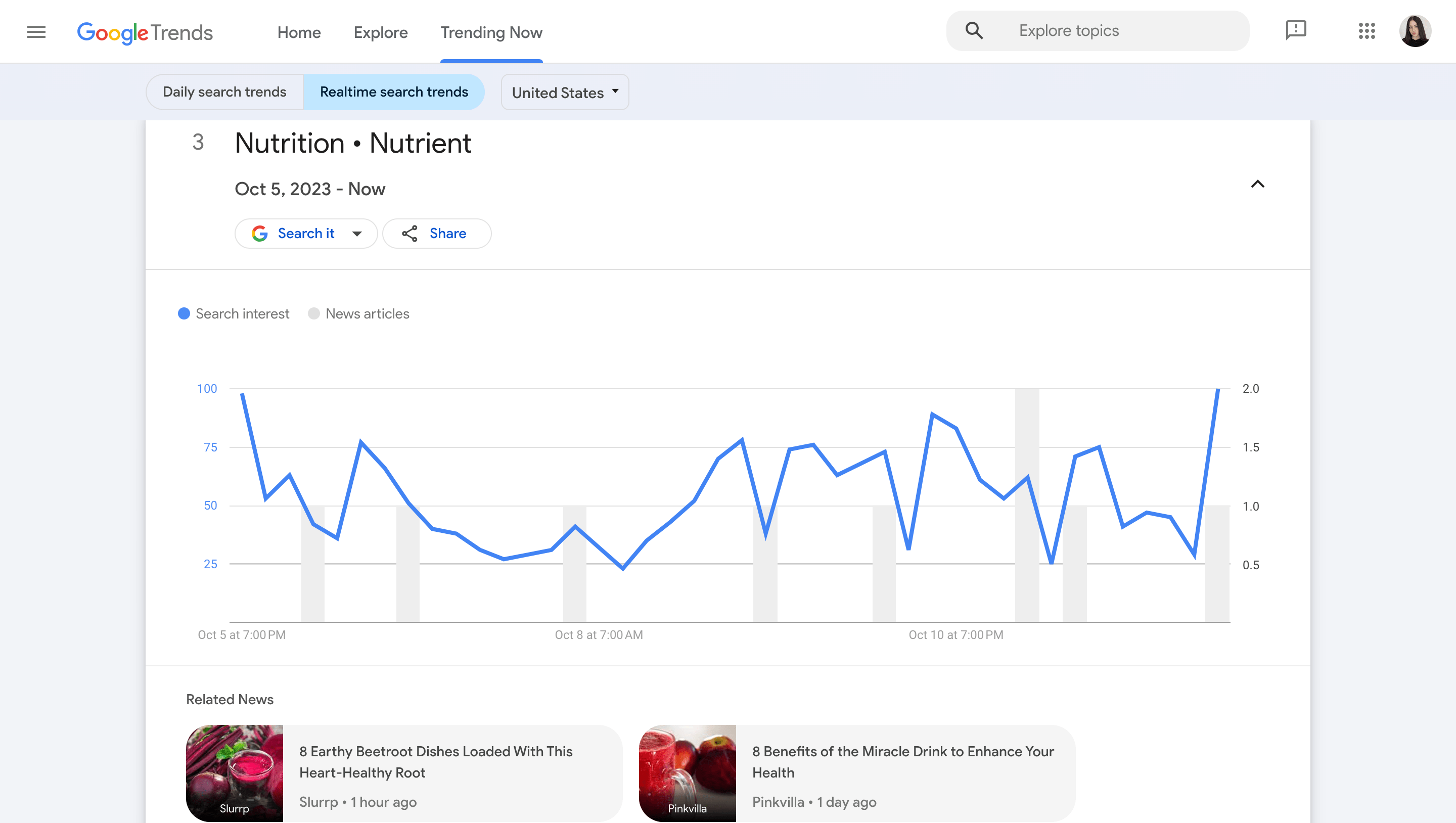
By staying on top of the latest trends, you can find hot topics to write articles about or share on social media. This has the potential to drive huge amounts of traffic to your site.
It’s also possible to check search trends through our keyword research tool. Just go to the top of the Overview section to see monthly changes in search volume for your chosen keyword.
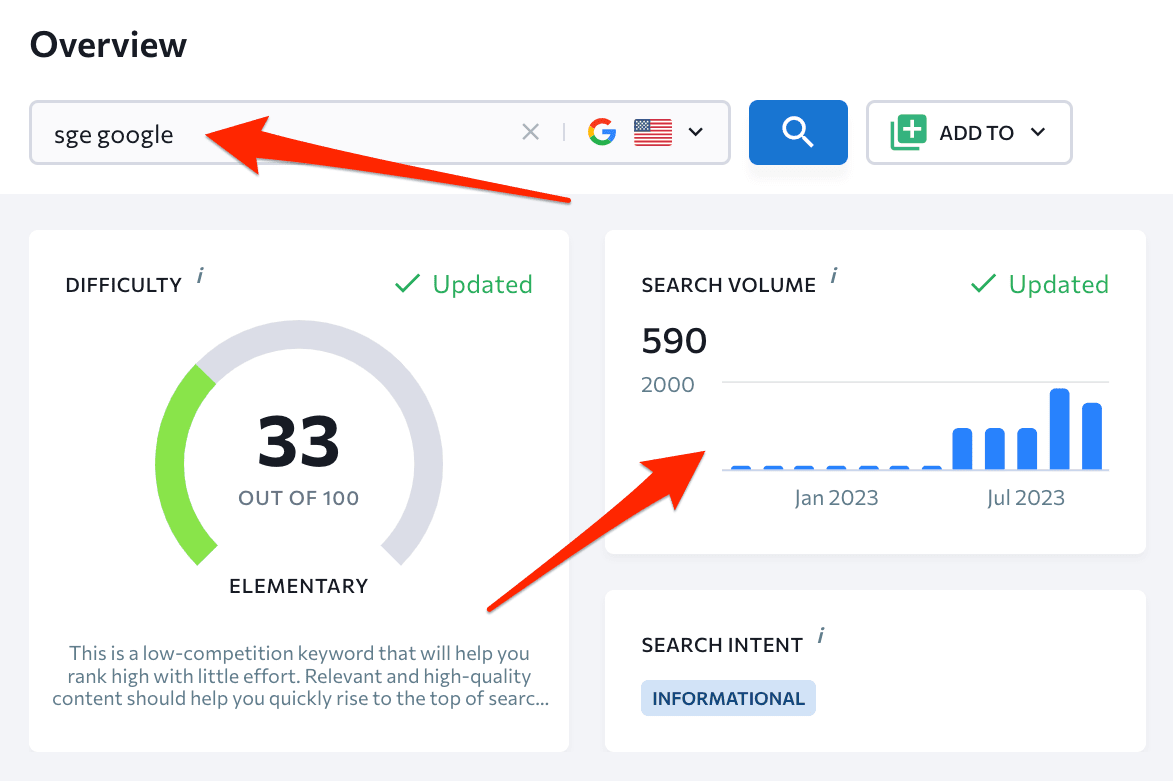
Evergreen Keywords
Last but not least, let’s focus on evergreen keywords.
These search terms are consistently relevant and remain popular over long stretches of time. Their search volume and relevance typically stay the same, and they drive search traffic and interest continually throughout the year.
Evergreen content deals with common issues or queries that most people have. Some examples of evergreen keywords include:
- best healthy eating tips
- how to improve time management skills
- home organization ideas
- 10 ways to stay motivated
By producing content around evergreen keywords, you can create a sustainable content strategy, build authority and credibility within your niche, and sustain a dedicated and engaged audience.
But despite the wealth of advantages that these keywords offer, there are some challenges you need to be prepared for when targeting them.
Firstly, if a topic is “evergreen,” chances are that it has already been written about extensively by your competitors. You’ll probably have a difficult time contributing meaningfully to this topic or writing something new and unique. Plus, evergreen topics tend to be very broad and generic.
Evergreen keywords are also highly competitive and challenging to rank for. This is especially true for small businesses. To rank for these search terms and attract the right audience, it is essential to produce high-quality, unique content that stands out in a crowd of competitors.
Summing It Up
Categorizing keywords into diverse groups and then incorporating them into your content marketing strategy is key to reaching a broad audience, optimizing SEO performance, and improving content relevance.
When appropriate keyword types are included in relevant content, you’ll receive a ‘yes’ response from search engines like Google. Just be mindful to use keywords naturally—keyword stuffing can do more harm than good and may lead to ranking penalties. After that, it’s only a matter of time before you start ranking at the top of the SERP for relevant queries and begin generating valuable leads.

